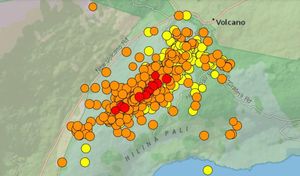The global real estate market is experiencing notable shifts, characterized by stabilization and growth across various regions. A recent analysis reveals how different markets are adapting to the changing economic climate, leading to renewed buyer interest and diverse strategies employed by real estate professionals.
Focusing on North America, particularly Canada, the Barrie and District Association of Realtors (BDAR) reported impressive statistics concerning home sales and prices. September saw 564 homes sold within Simcoe County, marking an 11.9% increase from last year. The average sale price rose to $858,422, reflecting a consistent upward trend as the local market adjusts to buyer demands and fluctuates across listings. "September's statistics reveal a market maintaining its upward momentum," remarked BDAR chair Lindsay Percy.
Bradford's market mirrored this trend albeit with some fluctuations. The average price of homes sold reached slightly above $1 million, indicating the area's appeal remains strong, yet the number of sold homes dropped by 21.4% compared to last year. Despite this drop, active listings saw growth, pointing toward increased inventory and competitive conditions for homebuyers.
Meanwhile, Ontario's broader housing market statistics submitted by the Canadian Real Estate Association (CREA) illustrated broader stability. The average single-family home price fell by 4.5% year-over-year, showcasing varying trends across regions but remaining relatively stable month-to-month since February. CREA senior economist Shaun Cathcart suggested buyers might delay purchases, anticipating faster rate cuts, leading to potential rebounds next year.
Turning to Asia, particularly India, the upcoming festive season is projected to ignite local housing market prospects significantly. According to CBRE, the traditional festivals inspire heightened buyer interest, predicting substantial demand growth reminiscent of earlier years. Over 150,000 units were sold during the first half of 2024, and this number is only expected to rise.
India’s luxury segment is experiencing particularly high interest, especially among high-net-worth individuals and non-resident Indians, attracted by potential investment returns amid global economic uncertainty. Developers are responding to this uptick by rolling out offers including EMI waivers and complimentary amenities, all aimed at capturing buyer attention as the market rallies.
Looking globally, market trends indicate the need for adaptation among real estate professionals. The office sector, which faced severe challenges due to the pandemic's impact, is now reportedly stabilizing. William Sankey, CEO of real estate software firm Northspyre, asserts the worst might be over for offices, as occupancy levels are finally shrinking after prolonged highs—even marked down for the first time in five years. Improvement signals something of resilience amid transformation within this asset class.
The nuanced dynamics of the office market reflect broader market conditions, as demand shifts from traditional office spaces toward more flexible arrangements, partly born out of pandemic-induced changes. This transformation highlights serious innovations required to boost occupancy and return office spaces to full operational statuses.
With recent government policies introducing optimizations backing the stabilization of real estate markets—such as Shanghai easing restrictions on home purchases—investors are beginning to find grounding for future investments. These policies are set to entice buyers who have previously held off due to economic uncertainties.
Looking at the potential impacts on investors, the multifamily segment is gaining traction with projected housing demand escalation expected due to population growth across key markets. Property experts note this segment rebounds significantly faster, aligning with rising rental demands and offering substantial security for real estate portfolios.
Combining multiple global perspectives, it's clear the real estate industry is at a tipping point where innovation and responsiveness to buyer behavior are pivotal. The efforts to stabilize fluctuated markets are yielding positive results. Communities, too, are witnessing the benefits as increased property sales signal revitalization and optimism. This momentum potentially sets the stage for future growth with investors sliding back comfortably to explore opportunities once deemed too risky.
Therefore, as various markets gear up for the commencing seasons, the overarching sentiment across the globe’s real estate sector is one of optimism, entering this pivotal moment with renewed vigor to not only stabilize but also expand horizons. Consolidated experiences and learning from this downturn could translate to sustainability and growth, allowing the industry to adapt fluidly to changing buyer behaviors.



